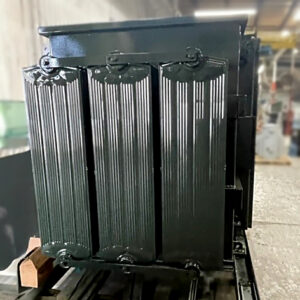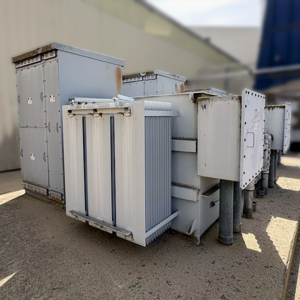By Jason Malinak, Senior Project Manager
Whether you have one or hundreds of transformers in your fleet, you need a maintenance plan to keep everything running optimally. The task of maintaining a fleet may seem daunting, but we can help you accomplish it in 5 steps.
Your transformers play a crucial role in generating, transmitting, and distributing electrical power across your business’s operations. Given their essential role, it is crucial to regularly evaluate and maintain these devices to prevent any potential downtime. Preparing and implementing an effective maintenance strategy for your equipment enables you to proactively identify and address potential issues as well as minimize unplanned expenses. Additionally, a well-executed maintenance strategy will allow you to extend the lifespan of your transformers, ensure optimal performance, and contribute to a safer work environment for your team. Below, we will outline a recent project we worked on and the recommended steps used that helped us find solutions for our customer.
Our Recent Project & the Results

The project that our team at SWE just completed involved us evaluating a customer’s fleet of more than 160 transformers over the course of 1.5 months and developing a comprehensive assessment and maintenance strategy. These transformers were distributed across fifteen sites, spanning two countries, necessitating extensive coverage and evaluation.
Using the steps outlined later, we were able to provide an effective and cost-efficient maintenance plan that supported the urgent and future needs of the customer. Almost 70% of the transformers needed an immediate inspection or maintenance performed. As a result, we split the 15 sites into 4 zones and managed them at the same time to provide urgency and efficiency.
Another solution achieved was determining the number of spares needed to support future maintenance plans. 63 primary transformers were found to be without a spare in case of downtime, which increased the customer’s risk. To reduce the risk and cost, our engineers used their experience and creativity to generate only 7 new transformer spare designs that supported the remaining transformers. We achieved this by customizing the designs to serve multiple purposes interchangeably.
When tackling a project of this magnitude, there are a variety of factors that come into play during the evaluation of customer transformers and the formulation of recommendations. Having a set of steps to follow can help lead to more meaningful and efficient solutions.
5 Steps Toward a Plan
To begin the process of finding a solution, there are 5 specific steps we follow. These steps allow our team to follow a progression escalating from gathering and consolidating all relevant data to the evaluation, design, and presentation of our findings and solutions to the customer.
Step 1: Gather Data / Identify the Equipment:

When beginning the process of crafting a solution, it is important to focus on collecting thorough data for each transformer. Knowing the parameters of the equipment involved is key to gaining insight into the condition and overall state of the customer’s transformers. The data received from the customer will provide a blueprint of the transformers.
We ask the customer to provide the following details for every product:
- Type: The purpose the transformer was designed and used for.
- Power Rating: Power level in kilovolt-amperes (kVA) or megavolt-amperes (MVA).
- Voltage Rating: Primary and secondary voltage levels in kilovolt (kV).
- Performance: The efficiency of the transformer to provide power.
- Maintenance: Which maintenance, if any, has been performed in the past.
- Usage: Is it actively being used or is it a spare?
These variables give us a general idea of the scope the project encompasses as well as the equipment’s general information. It is crucial to pour through the content and take note of what additional data we need to properly understand the health of the transformer. Any missing data points can lead to lost time and delays in the project. As mentioned before, being thorough with the data collection can save time in the long run.
We use this data collection process to achieve two primary end objectives:
- Gather specific information to recommend an effective maintenance strategy.
- Prepare a list of spare backup transformers for when units require maintenance and need to be taken offline.
These two objectives allow the customer to strategically deploy backup transformers when performing maintenance or replacing their primary transformers. Thoroughly gathering data at the beginning stages of the project ensures that there will be no need to double back and regather information later that might affect the framework we already began putting in place. This is where being diligent in the details and asking questions is a must!
Step 2: Organize the Data for Evaluation:

Once we identify and gather all project relevant data points, it is time to organize all the data into groups:
- Transformer Site: Transformer location.
- Transformer Power Rating: The power level in (kVA/MVA).
Once we compile and organize all the data, we can determine the location of each transformer and confirm the required maintenance. In addition, the data will give us insight into what specifications we will need to consider when designing new spares for the customer.
Step 3: Evaluate the Data:
The next step is to evaluate the data. This evaluation process reveals the state of the fleet and the path forward. You can complete this process in two phases.
Phase 1: Determining Transformer Health
Separate the transformers into two categories, good or bad health, based on recent inspection data or missing/outdated inspection data. To do so, we look at three different variables to determine whether the transformer is in good health or bad health:

1.) Inspection Results: The list of items in the transformers that were tested, their condition, and any notes regarding issues or areas of concern.
2.) Criticality Score: This is based on the degree to which the transformer needs evaluation and/or replacement. A high score means the transformer needs priority and a maintenance check. A low score means low priority. This data helps us estimate the overall health of the transformer.
3.) Manufactured Year: Transformer’s reliability may decrease with age due to material breakdown. Knowing the manufactured year can give us a good starting point for designing the maintenance plan.
 Good Health: If these three factors determine the health is good, we recommend a standard maintenance strategy with the goal of prolonging the life of the customer’s transformers. The plan consists of visual, mechanical, and electrical inspections with the frequency of testing depending on the overall transformer condition.
Good Health: If these three factors determine the health is good, we recommend a standard maintenance strategy with the goal of prolonging the life of the customer’s transformers. The plan consists of visual, mechanical, and electrical inspections with the frequency of testing depending on the overall transformer condition.
 Bad Health: If the health is bad, we recommend an immediate action plan to improve the health and prevent future issues. This is crucial because, if not resolved, the transformer may have poor efficiency, create an unsafe environment, and even fail altogether. This action plan typically includes thorough inspections and tests with the end goal of pinpointing what critical issues the designated transformer is experiencing. Once identified, we can move forward with recommending a maintenance plan to prevent further issues.
Bad Health: If the health is bad, we recommend an immediate action plan to improve the health and prevent future issues. This is crucial because, if not resolved, the transformer may have poor efficiency, create an unsafe environment, and even fail altogether. This action plan typically includes thorough inspections and tests with the end goal of pinpointing what critical issues the designated transformer is experiencing. Once identified, we can move forward with recommending a maintenance plan to prevent further issues.
Step 4: Determine the Number of Spares
Supporting downtime during maintenance or equipment failure is a crucial factor in transformer maintenance. To determine the number of spares needed to support downtime, there are things to look at and do.
 Calculate the Required Number of Spares: For maintenance, all transformers will need to be taken offline at some point to optimize the transformer’s performance. Determining if a transformer is the primary or a backup will help determine if you need a spare transformer. The spares will take their place to minimize disruption to the customer’s business.
Calculate the Required Number of Spares: For maintenance, all transformers will need to be taken offline at some point to optimize the transformer’s performance. Determining if a transformer is the primary or a backup will help determine if you need a spare transformer. The spares will take their place to minimize disruption to the customer’s business.- Minimize the Number of New Transformer Designs: If there are not enough spares available to cover the fleet, new ones must be designed. The goal then becomes to minimize the number of new spares by designing them to be interchangeable and cross functional. This will make maintenance easier and reduce cost on the customer’s end.
Step 5: Present the Recommended Maintenance Plan
The last step is putting together the findings and reporting them to the customer. We are then able to set up a meeting, show the findings to the customer, provide a recommended maintenance plan, and talk about the next steps. This gives the customer a clear understanding of their business risk with each transformer as well as a path forward with their units.
Conclusion
Initially, tackling large projects can feel overwhelming due to the sheer number of transformers requiring attention. However, by prioritizing a variety of variables, we can swiftly deliver recommendations aimed at mitigating business risks while also minimizing maintenance costs.
Here at Southwest Electric Co., we provide electrical solutions and equipment manufacturing for energy generation, distribution companies, and a variety of industrial markets. We offer a wide range of services, including engineering and design for custom product development, national field service, preventive maintenance, in-house repair, and specialty OEM logistical services.
Need help assessing your transformer’s health? Are you in need of a maintenance strategy?
Reach out to us today for a quote!
